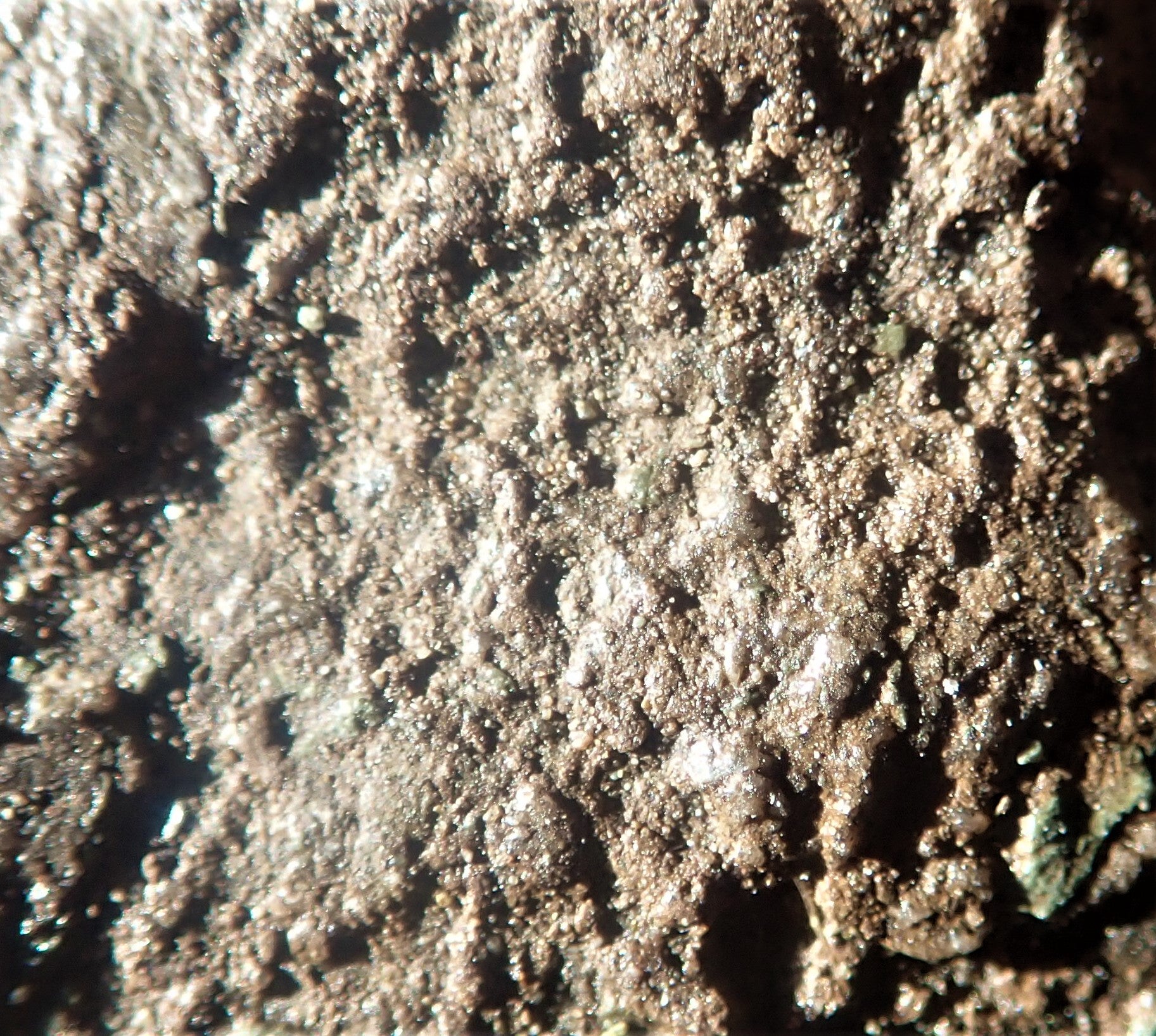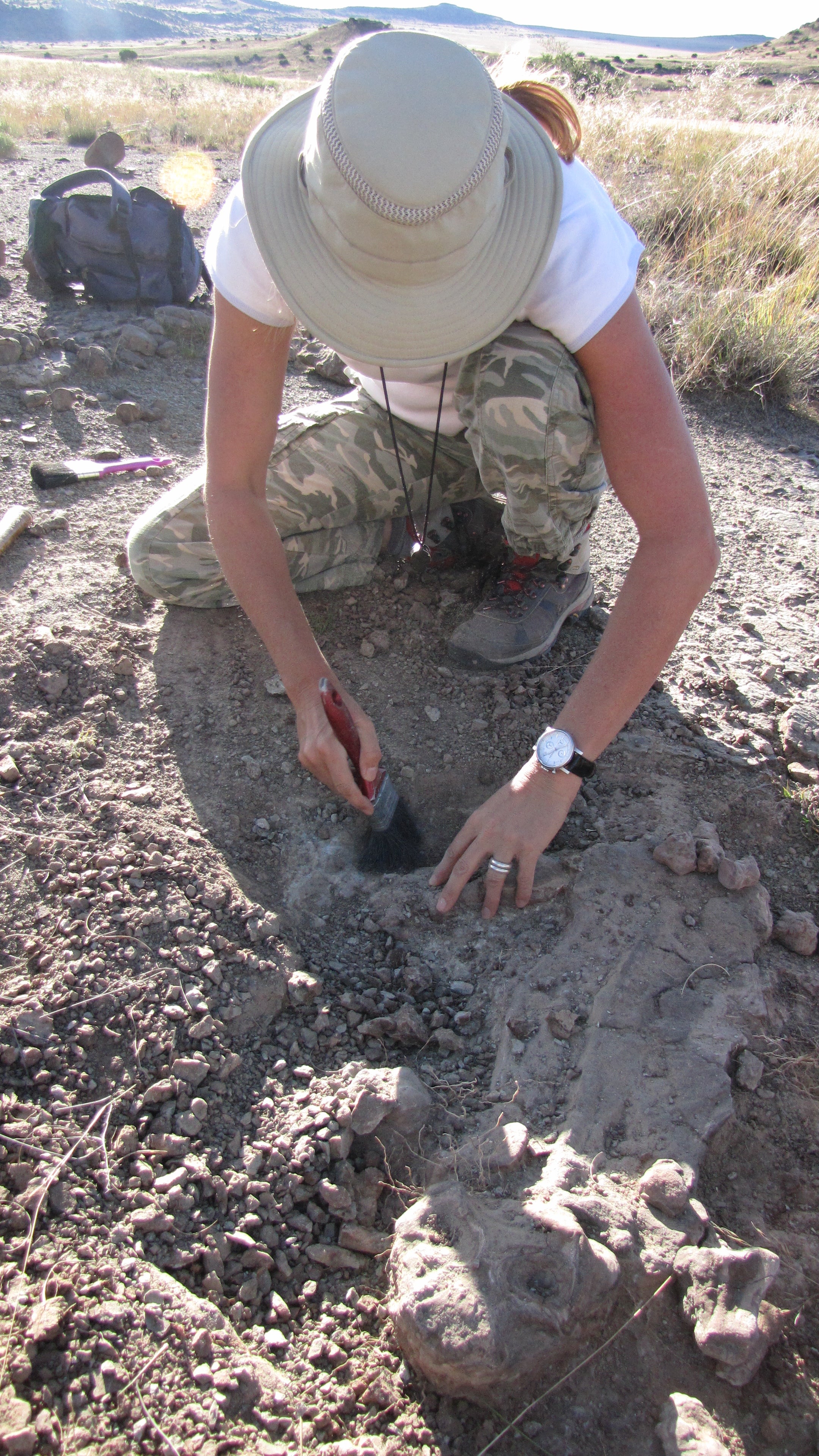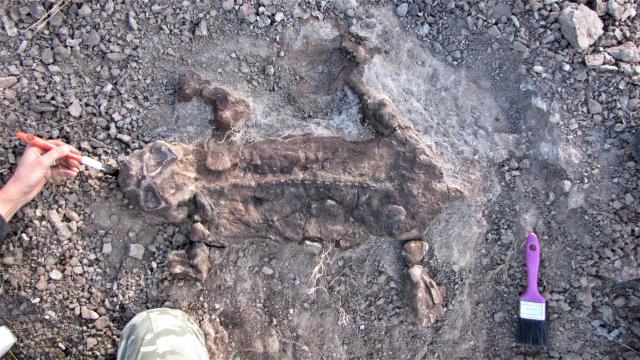It was a time of catastrophic change. Most of life on Earth had been wiped out, global temperatures had increased dramatically, and the weather raged in extremes. That anything survived in this hostile environment is remarkable, and yet, some plants and animals persisted. One such survivor was Lystrosaurus, a four-legged herbivore with a beaked snout and two pointy tusk-like teeth. And now, over 250 million years later, paleontologists have uncovered two fossils of these little animals complete with mummified skin.
This exciting discovery is described in a paper published in Palaeogeography, Palaeoclimatology, Palaeoecology. The two Lystrosaurus fossils are among 170 fossils from the Karoo Basin in South Africa studied in this paper. The Karoo is one of a handful of places in the world that records the boundary separating the Permian and the Triassic periods, a boundary that includes the End-Permian Extinction Event (EPME) that killed most marine and terrestrial life approximately 252 million years ago.
Lead author Roger Smith has been working there for 47 years. He’s a distinguished professor at the Evolutionary Studies Institute of the University of the Witwatersrand and an Emeritus Research Associate at Iziko South African Museum in Cape Town. He and his colleagues Jennifer Botha and Pia Viglietti studied an outcrop that is a known Lystrosaurus hot spot, having produced more than 500 fossils. But for this paper, they focused on 170 tetrapod fossils–a term referring to four-legged vertebrates–all of them from a time known as the Induan Age, which covers the million years after the EPME. Among the many fossils studied in this outcrop, clusters of four to eight Lystrosaurus fossils were found close together, their bodies spread-eagled, two of them preserving mummified skin.
That skin, Smith explained in a video call, almost matched what he had predicted: the animal didn’t have hair, as evidenced by the lack of hair follicles, but it wasn’t scaly, either. Noting the scales often don’t preserve, he compared it to elephant skin: leathery but with dimples. “The idea that it was like a transitional fossil — between scaly and true hairy — it’s almost borne out by the texture of that skin,” he said.

Juan Carlos Cisneros is a paleontologist at the Federal University of Piauí in Brazil. Although not involved in this research, he, too, has worked in the Karoo Basin and has previously collaborated with Smith. “This is the closest to taking a photograph of them at that time,” he said, comparing the mummified fossils to “a time capsule.”
“We’re usually happy with nice teeth, nice bones, and once in a while we find a complete skeleton. But nobody else finds mummified skin. Not at that age, for sure! We’re talking about things that are older than dinosaurs,” he enthused. “Nobody finds that kind of beautiful preservation, so detailed, at that time.”
What provides exquisite insight into animals over 250 million years old is also an indication that they met a horrible end. Examination of the bone microstructure of two of the fossils suggests they were young. The authors believe that the position and age at which these animals died are clues that they collapsed near a dried-up water source. They point to examples of today’s young elephants in similar drought circumstances, which die from starvation in a spread-eagled “sudden death posture” and whose skin, notably, dries out quickly and also mummifies.

These clusters of fossils, along with the others studied in this outcrop, indicate that herds of young Lystrosaurus died as a direct result of drought. Substantial evidence for drought is found in the sedimentary layers in the Karoo Basin, in geochemical isotopic analysis, and within these and other fossils described in a number of papers. Which is why it is surprising that Smith maintains that “Even though the world had been devastated, the resulting ecosystem was still fully functioning.”
In other words, the planet may have been completely transformed — and into a hostile one at that — but life, paraphrasing the words of a major motion picture, still found a way.
Evidence suggests that terrestrial animals in the Karoo at this time grew fast, matured earlier, lived short lives, and were generally smaller. Species of Lystrosaurus during the Permian, for example, were bigger than those found in the Triassic, but it is also important to note that all of the Lystrosaurus fossils yet discovered from the Triassic are of juveniles and subadults.
Cisneros compared the size of Lystrosaurus after the EPME to that of a small pig and said it “was the biggest land animal of that time. Everything that survived the mass extinction was small.”
“Before the extinction,” Smith concurred, “being big and heavy and a ruminant was the vogue. But afterwards, it was no longer successful.”
Burrowing underground is one of the behaviours believed to have helped Lystrosaurus survive the extinction and the extreme heat following that event. But that’s not all, and some of the other survival strategies involve, if not interspecies cooperation, then at least interspecies tolerance. In one example, the authors point to the fossils of two different Lystrosaurus species that died together, indicating that these species may have foraged for food together, rather than competing for it.
Sharing shelter with other contemporaneous species was another example. In three instances, multiple species including Lystrosaurus were found together in association with long tubular burrow casts, strongly indicating these animals sheltered — and died — together.
Within these ancient shared shelters, three of the species were four-legged reptiles (Thrinaxodon, Galesaurus and Lystrosaurus); one of them (Prolacerta) was a four-legged archosauromorph — a lineage that would eventually give rise to crocodiles and dinosaurs.
Smith said he and his colleagues are finding more evidence “now that these dinosaur ancestors were not only able to live there, but they were able to diversify and become the dominant animals into the Triassic. “This,” he concluded, “is the beginning of the rise of the dinosaur.”
While the causes of the EPME continue to be debated, the authors draw upon their work in the Karoo Basin to support the hyperthermal cause of extinction, meaning that Earth was catastrophically impacted by a volcanic eruption in the Siberian Traps around 252 million years ago, an event that changed the weather through the volcanic emission of greenhouse gasses and acidic particles. This had devastating consequences, including “vegetation die-off and drought (aridity with shorter and unpredictable periods of rain) on land,” Smith explained, as well as the “de-oxygenation and acidification of the oceans.”
“We are now treating this as a Pangea-wide hyperthermal,” Smith added, referring to the single continent that comprised land on Earth at that time. “Therefore, Pangea-wide drought episodes would be expected.”
This paper, he noted, is part of a larger project he and his colleagues have been working on within the Karoo Basin: only one of the many papers preceding it and other exciting papers yet to come.
“There is still much to be resolved,” Smith admitted, adding that he believes that when he and his colleagues have completed their research on the Karoo Permo-Triassic Boundary (PTB) Interval, he thinks they will be “recognised as the type locality for the terrestrial End Permian extinction event.”
“The Karoo has the best, the most complete fossil record of these tetrapods from the Permian Triassic,” Cisneros agreed. “If there’s anywhere in the world where you would expect to find it, it’s in the Karoo.”
Jeanne Timmons (@mostlymammoths) is a freelance writer based in New Hampshire who blogs about paleontology and archaeology at mostlymammoths.wordpress.com.
